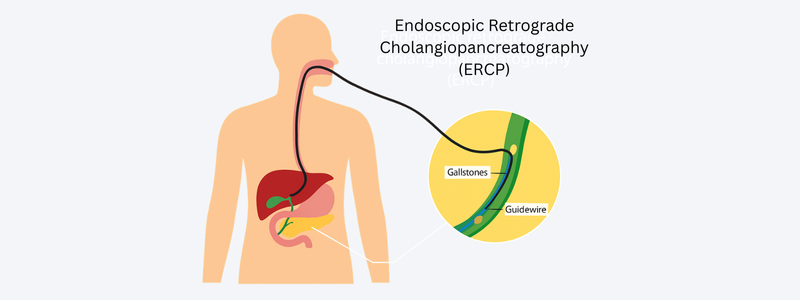
Endoscopic Retrograde Cholangiopancreatography (ERCP)
What is ERCP?
Endoscopic retrograde cholangiopancreatography (ERCP) is a procedure that combines upper gastrointestinal (GI) endoscopy and x-rays to treat problems of the bile and pancreatic ducts.
Why Our Physicians Use ERCP?
ERCP is used to treat problems of the bile and pancreatic ducts. Also use ERCP to diagnose problems of the bile and pancreatic ducts if they expect to treat problems during the procedure.
Our physicians perform ERCP when your bile or pancreatic ducts have become narrowed or blocked because of gallstones that form in your gallbladder and become stuck in your common bile duct.
- Infection
- Acute Pancreatitis
- Chronic Pancreatitis
- Trauma or surgical complications in your bile or pancreatic ducts
- Pancreatic Pseudocysts
- Tumors or cancers of the bile ducts
- Tumors or cancers of the pancreas
How do I prepare for ERCP?
To prepare for ERCP, talk with your doctor, arrange for a ride home, and follow your doctor's instructions.
Arrange for a ride home
For safety reasons, you can't drive for 24 hours after ERCP, as the sedatives or anesthesia used during the procedure needs time to wear off. You will need to make plans for getting a ride home after ERCP.
Don't eat, drink, smoke, or chew gum
To see your upper GI tract clearly, you doctor will most likely ask you not to eat, drink, smoke, or chew gum during the 8 hours before ERCP.
How ERCP is performed?
Our physicians who have specialized training in ERCP perform this procedure at a hospital or an outpatient center. An intravenous (IV) needle will be placed in your arm to provide a sedative. Sedatives help you stay relaxed and comfortable during the procedure. A health care professional will give you a liquid anesthetic to gargle or will spray anesthetic on the back of your throat. The anesthetic numbs your throat and helps prevent gagging during the procedure. The health care staff will monitor your vital signs and keep you as comfortable as possible. In some cases, you may receive general anesthesia.
You'll be asked to lie on an examination table. The doctor will carefully feed the endoscope down your esophagus, through your stomach, and into your duodenum. A small camera mounted on the endoscope will send a video image to a monitor. The endoscope pumps air into your stomach and duodenum, making them easier to see.
During ERCP
locates the opening where the bile and pancreatic ducts empty into the duodenum slides a thin, flexible tube called a catheter through the endoscope and into the ducts injects a special dye, also called contrast medium, into the ducts through the catheter to make the ducts more visible on x-rays uses a type of x-ray imaging, called fluoroscopy, to examine the ducts and look for narrowed areas or blockages.
Your doctor may pass tiny tools through the endoscope to open blocked or narrowed ducts.
- Break up or remove stones.
- Perform a biopsy or remove tumors in the ducts.
- Insert stents—tiny tubes that a doctor leaves in narrowed ducts to hold them open. A doctor may also insert temporary stents to stop bile leaks that can occur after gallbladder surgery.
The procedure most often takes between 1 and 2 hours.
What should I expect after ERCP?
After ERCP, you can expect the following:
You will most often stay at the hospital or outpatient center for 1 to 2 hours after the procedure so the sedation or anesthesia can wear off. In some cases, you may need to stay overnight in the hospital after ERCP.
- You may have bloating or nausea for a short time after the procedure.
- You may have a sore throat for 1 to 2 days.
- You can go back to a normal diet once your swallowing has returned to normal.
- You should rest at home for the remainder of the day.
Following the procedure, you or a friend or family member who is with you if you’re still groggy will receive instructions on how to care for yourself after the procedure. You should follow all instructions.
Some results from ERCP are available right away after the procedure. After the sedative has worn off, the doctor will share results with you or, if you choose, with your friend or family member.
If the doctor performed a biopsy, a pathologist will examine the biopsy tissue. Biopsy results take a few days or longer to come back.
All other services provided
After the procedure, you can expect:
Colon polyps are small masses of cells that are benign, but could become cancerous. They are detected and can be removed during a sigmoidoscopy or colonoscopy.
Esophagus tests measure muscle activity to diagnose problems with the esophagus. This usually includes measuring the acidity with pH testing and testing the muscle contractions with esophageal manometry.
Capsule camera endoscopy is a non-invasive examination to search for bleeding in the small intestine. A patient swallows a capsule that has a small camera to send video data to an external data recorder. The capsule passes out of the body in one to two days.
A flexible sigmoidoscopy is a minimally-invasive examination of the lining of the lower large intestine to evaluate gastrointestinal symptoms, such as abdominal pain, rectal bleeding, or changes in bowel habits. A sigmoidoscope is used and is a long, flexible, tubular instrument.
An ERCP is a procedure used to diagnose diseases of the gallbladder, biliary system, pancreas, and liver. ERCP combines endoscopy and x-ray in order to identify bile ducts, administer a contrast agent, and view x-rays of digestive bile ducts.
A percutaneous endoscopic gastrostomy is a simple surgery to place feeding tube directly into the stomach through the abdominal skin to allow enteral feeding, bypassing the mouth and esophagus.
Esophageal dilation is a procedure used to expand a narrowed esophagus by using an endoscope with a balloon or plastic dilators over a guiding wire. This narrowing often occurs with scarring due to acid-reflux diseases.
